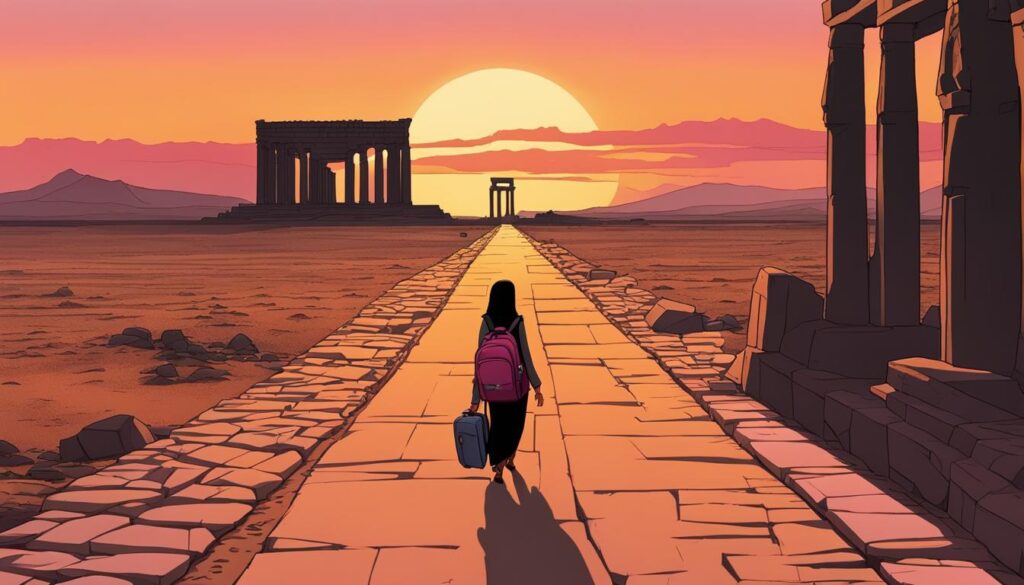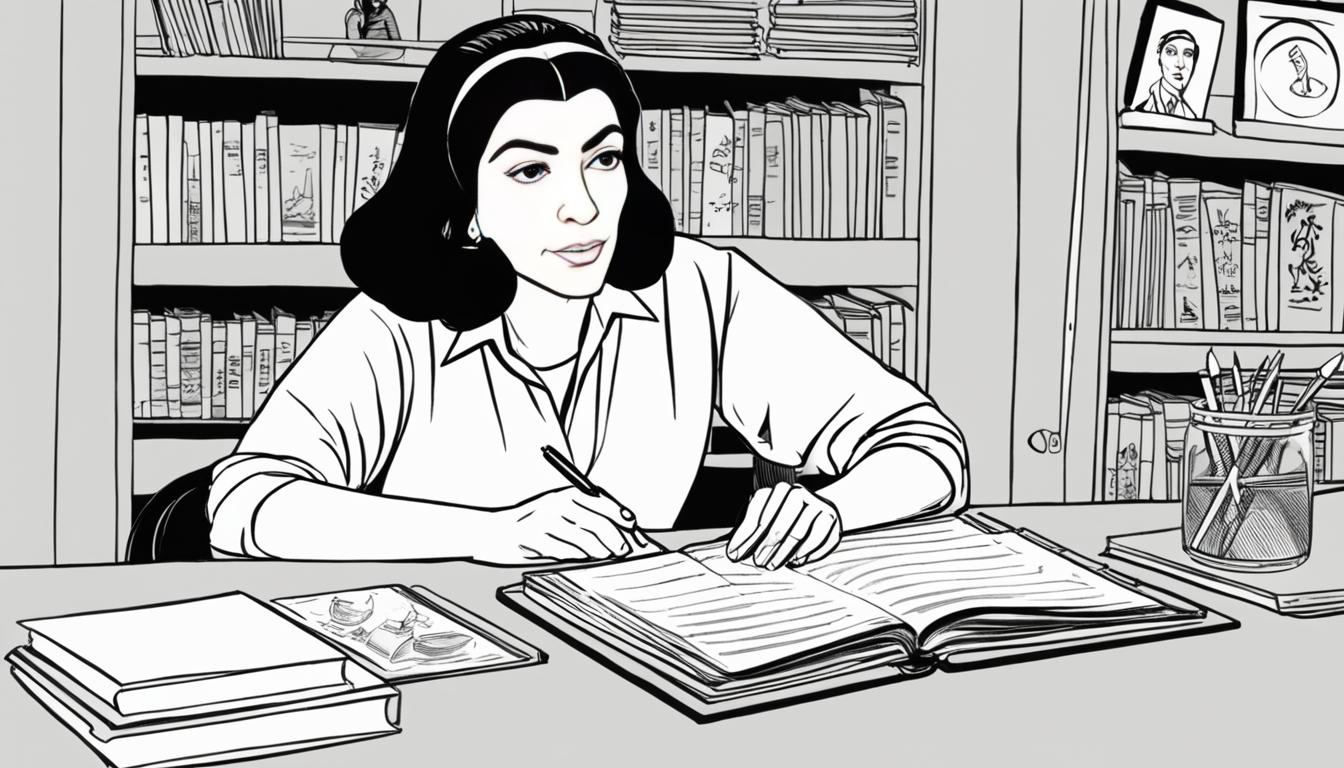Marjane Satrapi’s “Persepolis: The Story of a Childhood” is a gripping and emotional book that explores Satrapi’s experiences during the Iranian revolution. Presented in graphic novel format, this book offers readers a unique perspective into the complexities of growing up during a time of social and political upheaval.
Satrapi, a gifted storyteller, takes readers on a journey through her childhood and the challenges she faced in a world that was rapidly changing. Through her beautiful and poignant illustrations, she conveys the turmoil of those times and the resilience it took to navigate through them.
This book is a must-read for anyone interested in the human experience during historical events. It offers a powerful message of hope and showcases the strength of the human spirit in the face of adversity.
Key Takeaways
- “Persepolis: The Story of a Childhood” offers a unique perspective into the Iranian revolution through the eyes of a child growing up during that time.
- Satrapi’s storytelling and beautifully illustrated graphic novel format make this book an emotionally engaging read.
- The book’s themes of resilience, identity, and the power of storytelling resonate with readers worldwide.
- “Persepolis” has cultural and historical significance in raising awareness of important social and political issues.
- This book is an inspiring example of the strength of the human spirit in the face of adversity.
About Marjane Satrapi
Marjane Satrapi is an Iranian-born French author, illustrator, and filmmaker who is best known for her graphic novel, “Persepolis: The Story of a Childhood.” Born into a politically active family in Iran, Satrapi’s life was shaped by the events of the Iranian Revolution and subsequent war with Iraq.
Satrapi left Iran in 1983 and eventually settled in France, where she continued her education and began her career in the arts. Her experiences as an Iranian woman living in Europe inspired much of her artwork.
Over the past few decades, Satrapi has become a highly regarded figure in the world of graphic novels and independent filmmaking. She has received numerous awards for her work, including the Angoulême International Comics Festival Award for Best First Comic, and the Cannes Film Festival Jury Prize.
“I believe that an artist’s life should be ephemeral. Some novels are nothing but a long footnote to a biography.”
Exploring “Persepolis: The Story of a Childhood”
“Persepolis: The Story of a Childhood” is a deeply profound graphic novel that provides a unique insight into the Iranian Revolution through the eyes of its author, Marjane Satrapi. The book offers readers an opportunity to connect with Satrapi’s experiences, reflecting on the challenges, hardships, and cultural differences that shaped her childhood.
The narrative structure of “Persepolis” is exceptional, as Satrapi weaves together key events from her life to create a powerful story of personal resilience. The combination of words and images allows the story to be told in a highly emotive and impactful way, touching readers on an emotional level.
The impact of the book goes beyond its exploration of the Iranian Revolution. Satrapi’s story is universal, and readers worldwide have connected with the book’s themes of identity, resilience, and the power of storytelling. The book has been adapted into an animated film and stage production and has received critical acclaim, cementing its place in literary history.
| Themes | Narrative Structure | Impact |
|---|---|---|
| The book explores themes of family, identity, resilience, cultural difference, and the power of storytelling to convey personal experiences. | The narrative structure is exceptional, as Satrapi weaves together key events from her life to create a powerful story of personal resilience. | The book has had a significant impact, connecting with readers worldwide and provoking thought on important socio-political issues. |
“Persepolis: The Story of a Childhood” is a must-read for anyone interested in exploring the human experience through storytelling. It has left an indelible mark on literature and will undoubtedly continue to inspire readers for years to come.
Understanding the Revolution
The Iranian revolution, also known as the Islamic Revolution, was a period of political unrest and upheaval that took place between 1978-1979. It was a time of profound social, cultural, and political change that transformed Iran’s society and government.
At the heart of the revolution was a call for democratic representation and the end of the authoritarian rule of the Pahlavi dynasty, led by Shah Mohammad Reza Pahlavi. The revolution also aimed to promote Islamic values and culture, which had been suppressed under the Shah’s regime.
Marjane Satrapi’s experiences during this period are a testament to the challenges faced by millions of Iranians during this time. Her story highlights the impact of political upheaval on everyday people and families, and it serves as a powerful reminder of the resilience of the human spirit.
The revolution led to significant changes in Iran, including the establishment of an Islamic Republic and the implementation of a new constitution. However, it also resulted in widespread violence and repression, including the execution of political dissidents and the suppression of civil liberties.
Despite these challenges, the Iranian revolution remains a significant event in world history and a testament to the power of collective action to effect change. Satrapi’s “Persepolis” provides a window into this world and the power of storytelling to convey personal experiences during times of revolution.
Marjane’s Journey
Marjane’s journey throughout “Persepolis: The Story of a Childhood” is one of personal growth and self-discovery. From a young girl grappling with the realities of war and revolution, to a confident young woman embracing her identity and standing up for her beliefs, Marjane’s character development is both inspiring and relatable.
Throughout the book, Marjane faces numerous challenges that test her resilience and determination. The loss of loved ones, the constraints of societal expectations, and the complexities of adolescent relationships are just a few of the obstacles in her path. But through it all, Marjane never loses sight of who she is and where she comes from.
Marjane’s unwavering spirit and courage are a testament to the power of the human spirit. Her story resonates with readers of all ages and backgrounds, encouraging us to embrace our own journeys and never give up on our dreams.

“I was a Westerner in Iran, an Iranian in the West. I had the best of both worlds, yet I was an outcast in both. Or an insider to both. I never knew which. I didn’t really understand Iran until I left it. I was too immersed in it.”
Themes in “Persepolis”
Through “Persepolis,” Marjane Satrapi explores various themes that are relevant to readers worldwide. The most prominent themes include resilience, identity, and the power of storytelling to convey personal experiences.
Resilience
One of the most inspiring themes in “Persepolis” is resilience. Satrapi demonstrates an unshakeable determination to persevere through adversity, and her journey serves as an inspiration to readers facing similar struggles. Despite facing numerous challenges, including war and political turmoil, Satrapi’s unwavering bravery serves as a reminder that even in the darkest of times, hope and resilience can shine through.
Identity
Another vital theme in “Persepolis” is identity. Set against the backdrop of the Iranian revolution, the book highlights the importance of personal identity in times of political and social upheaval. Through Satrapi’s experiences, readers witness how political and social situations can shape personal identity and the importance of understanding one’s own cultural heritage, despite external pressures to conform.
The book also highlights the universal nature of identity, underlining that everyone has their unique blend of cultural, social, and political influences that impact their identity.
The Power of Storytelling
“Persepolis” is a graphic novel that explores the power of storytelling to convey personal experiences. Through Satrapi’s unique artistic style and techniques, the book takes on a transformative power that transports readers to another world. The graphic novel format enhances the reader’s understanding of the narrative, allowing them to engage with the story in a more meaningful way.
To conclude, “Persepolis” is a must-read for anyone interested in the power of resilience, personal identity, and the human experience. Through its celebration of the human spirit’s resilience, the book serves as an inspiration for readers facing adversity. Satrapi’s masterful use of storytelling cements “Persepolis’s” place in world literature, making it one of the most popular and impactful books of our time.
Artistic Style and Techniques
Marjane Satrapi’s unique artistic style distinguishes “Persepolis” from other memoirs or graphic novels. Utilizing a simple, black-and-white palette, Satrapi effectively conveys complex emotions and ideas. The use of stark, unadorned panels creates an almost cinematic feel, allowing the reader to experience the story as if they are watching a film.
In addition, Satrapi’s use of the graphic novel format enhances the storytelling and the impact it has on the reader. Incorporating images and text in a harmonious way, Satrapi elevates the narrative to a new level, allowing for a deeper exploration of themes and characters.
“The combination of text and image in graphic narrative is especially effective because they work in tandem. In this way, the integrity of each art form is maintained, and the reader gains access to a different kind of storytelling.” – Hilary Chute
Furthermore, Satrapi’s use of shadow and light emphasizes the themes of duality and ambiguity throughout the book. By contrasting light and dark, Satrapi illustrates the complex relationships between individual and society, tradition and modernity, and the personal and the political.
Cultural and Historical Significance
Beyond its literary merits, “Persepolis” carries immense cultural and historical significance. Through Satrapi’s story, readers gain insights into the realities of the Iranian revolution and its aftermath, shedding light on an often-misunderstood part of the world.
The book provides a unique perspective on the experiences of Iranian women during the revolution and their struggles for equality in its aftermath. “Persepolis” also highlights the importance of storytelling as a means of preserving cultural memory and creating a greater understanding of the complexities of Iranian society.
The impact of “Persepolis” resonates far beyond Iranian borders. The book’s powerful themes of resilience and navigating personal identity amidst political turmoil speak to readers worldwide. As such, the book has become required reading in many universities and educational institutions, further cementing its place in the literary canon.
“Satrapi’s book isn’t a story of politics or history; it’s not dry or esoteric. It’s about a girl growing up and figuring out who she is, and it’s told through vivid, beautiful panels.” – The New Yorker
Conclusion
In conclusion, “Persepolis: The Story of a Childhood” by Marjane Satrapi is a powerful depiction of resilience, identity, and the impact of revolution on personal experiences. Satrapi’s unique artistic style and techniques in the graphic novel format enhance the storytelling and make for an impactful read. Through Marjane’s journey, readers are inspired to face adversity with tenacity and determination.
The book’s cultural and historical significance lies in its ability to address important socio-political issues and raise awareness worldwide. “Persepolis” has left an indelible mark on readers and continues to be a source of empowerment and inspiration.
Overall, “Persepolis” is a must-read for all ages. Its powerful message of resilience and the importance of storytelling is one that will stay with readers long after they have finished the book.
Book Summary: “Persepolis: The Story of a Childhood” explores Marjane Satrapi’s experiences during the Iranian revolution and her personal journey of resilience and self-discovery. Through the graphic novel format and unique artistic style, Satrapi’s story is brought to life and leaves a lasting impact on readers worldwide.



